The Samsung Galaxy Note20 Ultra 5G (Snapdragon) is the South Korean manufacturer’s business/consumer-oriented “phablet” destined for the U.S. market and China. The only difference compared to the previously tested Samsung Galaxy Note20 Ultra 5G model is the chipset, with the U.S./China version build around Qualcomm’s Snapdragon 865+ chip, as opposed to the Exynos 990 model sold in the rest of the world. With the chipset a crucial component for image signal processing and resulting image quality, it’s possible we’ll see some differences between the Snapdragon and global models in our tests. In this review we’ll share image quality analysis and examples from both versions of the Note20 Ultra 5G alongside other competitors.
Key camera specifications:
- Primary: 108 MP 1/1.33-inch sensor, 26 mm-equivalent f/1.8-aperture lens with laser & PDAF and OIS
- Telephoto: 12 MP sensor with 1.0µm pixels, 120 mm-equivalent periscope-style (5x optical) f/3-aperture lens with PDAF and OIS
- Ultra-wide: 12 MP sensor, 13 mm-equivalent f/2.2-aperture lens
- LED flash
- Video: 8K 4320p/24 fps, 4K 2160p/60 fps (2160p/30 fps tested)
- Snapdragon 865+ chip set
About DXOMARK Camera tests: For scoring and analysis in our smartphone camera reviews, DXOMARK engineers capture and evaluate over 3000 test images and more than 2.5 hours of video both in controlled lab environments and in natural indoor and outdoor scenes, using the camera’s default settings. This article is designed to highlight the most important results of our testing. For more information about the DXOMARK Camera test protocol, click here. More details on how we score smartphone cameras are available here.
Test summary
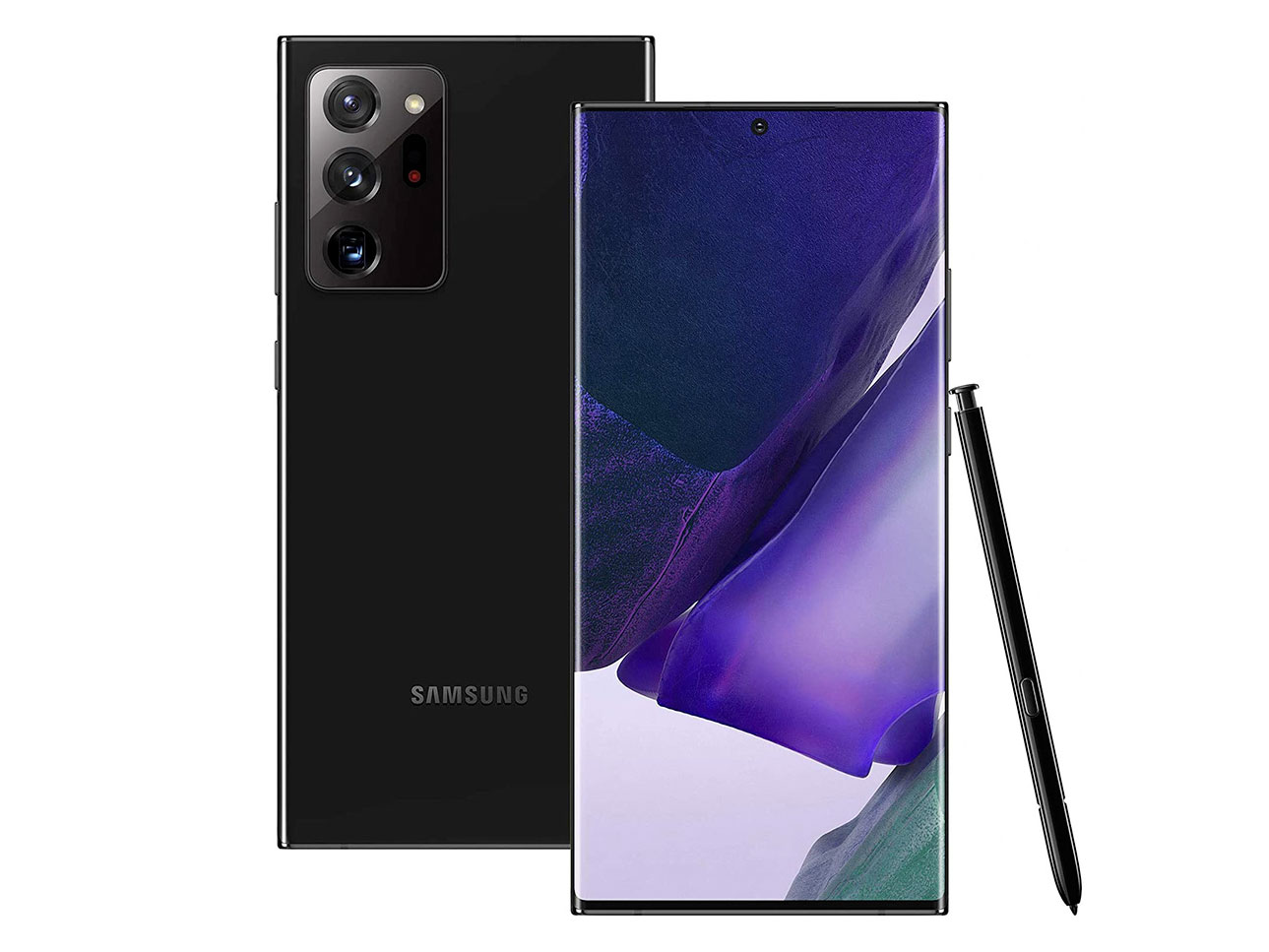
Samsung Galaxy Note20 Ultra 5G (Snapdragon)


While fairly competent overall and offering good photographic versatility across its three cameras, a couple of niggles in our analysis means the Note20 Ultra 5G’s performance is not quite as accomplished as the devices at the very top.
An overall DXOMARK Camera score of 117 puts the Samsung Galaxy Note20 Ultra 5G (Snapdragon) outside of the top ten in our Camera ranking; while the differences in image quality between the global-release Exynos version and the Snapdragon models aren’t too evident, they still had an impact. The Samsung Galaxy Note20 Ultra 5G (Snapdragon) posts a Photo score of 119, 3 points behind the Exynos at 122. The Snapdragon is a little better for color, texture, and artifacts when considering shots from the main camera, but the Exynos is just ahead in most other Photo categories.
By and large the Note20 Ultra 5G (Snapdragon) delivers nice exposures, even in low light, but limited dynamic range and inconsistent HDR activation in challenging scenes restrains its scoring potential. Color is a strength, too, thanks to vivid rendering and accurate white balance in most images. Fans of simulated bokeh also won’t be disappointed with shots from Portrait mode, which display a pleasant depth-of-field effect, including nice simulated spotlights as well as accurate depth estimation.
Texture results are also pretty good on the Note20 Ultra 5G (Snapdragon), and although detail is lower when the lights are dimmed, for the most part it holds its own against the top players. Noise is something of weaknesses, though, with the different processor in the Snapdragon model not reducing digital interference as effectively as we saw with the Exynos. In fact, output after 3×3 pixel binning from the 108 MP Quad Bayer sensor is broadly similar to results we saw on the standard-array sensor in last year’s Note10+ 5G.
Some fine-tuning of autofocus would go along way towards improving the score, too. While our engineers observed no serious autofocus failures, autofocus behavior is erratic, with our measurements recording large variations both in response times and in levels of sharpness recorded. A good-quality preview ensures for the most part that what you see on screen is what you get in the final capture, but better highlight rendering in high dynamic scenes and improved bokeh rendering using portrait mode would have bolstered the score of the Samsung Galaxy Note20 Ultra 5G (Snapdragon).
The Snapdragon is behind the Exynos in our night analysis, too, with lower scores for exposure, texture, and noise in this category. The Snapdragon model controls unwanted image artifacts fairly well, achieving a better score than the Exynos. Color quantization, evident as banding or patterns across color gradients, is the main culprit, but that aside, the Note20 Ultra 5G (Snapdragon) control artifacts well.
The Samsung Galaxy Note20 Ultra 5G (Snapdragon) achieves a score of 75 in our new Zoom metric, which combines the wide and zoom scores. In this area we see much closer scores between the two Samsung variants, although there are still some intriguing differences to note.
In zoom shots, both devices deliver good exposure, contrast and color, so a cursory glance at the screen shows results that are very satisfying. At close inspection, though, we see the same strong fusion errors on both devices, which result in inconsistent texture rendering across the frame and colored artifacts in both medium- and long-range zoom shots. Where the devices differ for zoom shots is in autofocus performance. We found the Snapdragon often struggled to find focus using long-range zoom, but was good at close range, whereas it was the other way around on the Exynos device.
The Samsung Galaxy Note20 Ultra 5G (Snapdragon) remains a top performer for ultra-wide shots, however, making this device a strong contender if you often find yourself wanting to include more in the frame. The 13 mm-equivalent focal length provides great coverage, and image quality is globally excellent, with accurate exposure, reasonable dynamic range, and nice color. Results are particularly successful outdoors, but even under dim artificial lighting, the wide module on the Snapdragon version captures nice results with neutral white balance and acceptable detail.
With a Video score of 103, the Samsung Galaxy Note20 Ultra 5G (Snapdragon) is closer to devices at the top of the list for moving image quality and comparable to the Exynos model at 106 points.
Target exposures in challenging lighting are lower on Snapdragon model, but both devices display wide dynamic range with good control of highlights. Color rendering is superior on the Snapdragon, though, with particularly neutral white balance under artificial lighting a good benefit, although skin tone rendering can be inaccurate in some circumstances. Luminance noise is well controlled in outdoor and indoor movies, but detail is noticeably lower in low light compared to the Exynos model.
Video stabilization is particularly effective in static handheld videos, and it’s not bad with walking or panning actions either, although a difference in sharpness between frames becomes slightly evident. Again we noticed irregular autofocus behavior, with abrupt transitions evident on the Note20 Ultra 5G (Snapdragon) as it tracks.
Photo scores explained
The Samsung Galaxy Note20 Ultra 5G (Snapdragon), achieves a Photo score of 119, just 3 points behind the Exynos version at 122. In this section, we take a closer look at the strengths and weakness for still photos to see how each sub-score was determined, with image quality comparisons against Samsung’s global-release version and one of the Note20 Ultra 5G devices’ key competitors, the OnePlus 8 Pro.

Exposure and Contrast
Samsung Galaxy Note20 Ultra 5G (Snapdragon)
82
111
A disappointing score for exposure due to limited dynamic range in high-contrast scenes, HDR activation failures, and underwhelming exposures in low light.
In this backlit scene, both Note20 Ultra 5G devices blow out the sky, although the Snapdragon version is fractionally better. The OnePlus 8 Pro is able to record much more highlight detail in this challenging scene while still maintaining acceptable brightness on the faces.
Inconsistent HDR activation on the Note20 Ultra 5G (Snapdragon) negatively impacted its exposure score under our new trustability analysis. Highlight rendering varied considerably over consecutive frames of the same scene.

Color
Samsung Galaxy Note20 Ultra 5G (Snapdragon)
100
107
One of the device’s main strengths, colors are bright and vivid in photos generally, with particularly successful results in outdoor scenes and bright lighting conditions. White balance is accurate and repeatable, too, with the Note20 Ultra 5G (Snapdragon) avoiding any serious color casts under low artificial lighting.
Overall color is satisfying and a slight improvement over the Exynos version. Here you can see slightly better saturation in the blues on the Snapdragon version.

Autofocus
Samsung Galaxy Note20 Ultra 5G (Snapdragon)
88
109
Significant instabilities in the accuracy and speed of the autofocus system is a key weakness. The Note20 Ultra 5G (Snapdragon) lands well down in our ranking of autofocus performance, with a lower score than the Exynos version. Measurement charts highlight the device’s erratic autofocus behavior in our benchmark testing. Snap-sharp speeds regularly varied between 100 ms and 500 ms, with levels of acutance (or sharpness) ranging from 100% up to 140%, where significant oversharpening is evident. To be fair, the Note20 Ultra 5G (Snapdragon) avoids any serious failures where shots are completely out of focus, but autofocus performance is inconsistent overall compared to the top devices we’ve tested in this category.
One some occasions our testers also found the Snapdragon version of the Note20 Ultra 5G to lock focus on the wrong subject. In this scene, the focus is on the subject in the back, rendering the front subject, which should be the one in focus, slightly soft. Both the Note20 Ultra with Exynos chipset and the OnePlus 8 Pro do a better job here.

Texture
Samsung Galaxy Note20 Ultra 5G (Snapdragon)
97
111

Noise
Samsung Galaxy Note20 Ultra 5G (Snapdragon)
70
102
The Note20 Ultra 5G (Snapdragon) fares better for texture rendering, with details generally well preserved in indoor and outdoor lighting conditions. Measurements indicate a small improvement over the Exynos version in lower light, with the Snapdragon model maintaining consistent acutance of around 80% between 5 and 1000 lux in handheld shots. There’s a significant drop in extreme low light (1 lux), but unless you’re regularly shooting shots in candlelight, you won’t have too many complaints.
In the examples below you can see the improvement in fine detail rendering that the Snapdragon Note20 Ultra 5G offers over the Exynos device in a challenging indoor scene.
Noise performance is one area in which we see a significant difference between the two Note20 Ultra 5G models, with the Snapdragon 10 points behind the Exynos in our measurements. In the chart below, we see that the OnePlus 8 Pro maintains a lower level of visual noise below both Samsung devices in all lighting conditions.
This analysis holds true when examining natural scene images, with noise usually visible in Note20 Ultra 5G images. In this indoor scene, it is clear that the files from the OnePlus 8 Pro are cleaner. Noise is also visibly stronger in the Note20 Ultra Snapdragon image than for the Exynos version.
The difference in noise between the Snapdragon and Exynos devices is also visible in this low-light shot.

Artifacts
Samsung Galaxy Note20 Ultra 5G (Snapdragon)
55
77
Control of image artifacts is another weakness for the Note20 Ultra 5G (Snapdragon), but its results are marginally better compared to the Exynos version. The phone loses the most points in this sub-score for color quantization, with obvious colored banding evident in many examples, ringing caused by oversharpening, and a hue shift resulting in inaccurate color rendering. Our experts applied smaller point deductions for ghosting, halos, flare, and color fringing, which are occasionally evident under certain lighting conditions.
In the example below, we see halos along contrast edges as a result of the HDR processing.
In this example, color quantization is evident around the desk lamp, where the device could handle color gradients better.

Night
Samsung Galaxy Note20 Ultra 5G (Snapdragon)
56
82
The Note20 Ultra 5G (Snapdragon) puts in a respectable performance in our after-dark tests. Performance is on the level of a top-end device, but the Snapdragon model is not quite as accomplished as the Exynos device overall. A difference is especially noticeable in texture rendering: the Exynos Note20 Ultra just manages to squeeze more fine detail out of night scenes than its Snapdragon counterpart, as you can see in the sample below. Exposure is good even in very dark night scenes, though.
The Snapdragon Note20 Ultra can sometimes also struggle with white balance in night shots. In this flash-off shot, the subject has very greenish/yellowish skin tones. The Exynos variant produces much more natural and pleasant skin tones. The OnePlus image also has a slight white balance cast but not quite as strong as the Note20 Ultra Snapdragon’s.

Bokeh
Samsung Galaxy Note20 Ultra 5G (Snapdragon)
70
80
Bokeh shots are a strength for the Note20 Ultra 5G (Snapdragon), where shots taken in portrait mode display a pleasant depth-of-field effect with uniform noise and nice blur gradient transitions, as well as good shape on the simulated spotlights. Depth estimation is also fairly accurate, but repeatability could be improved, as the effect did not always activate when requested.


Preview
Samsung Galaxy Note20 Ultra 5G (Snapdragon)
56
80
The preview image is fairly close to the final capture for exposure, but it does not control dynamic range well. As you can see in the comparison below, highlights often look very overexposed while framing an image, but are recorded better in the final image. This is important to know, as what you see on screen might be the difference between taking a shot or not.
Preview functionality is good, giving users the ability to pinch-zoom between 0.5x and 50x magnification, and the preview image remains relatively stable as the device switches between camera models. It is not quite as well controlled as we observed on the Exynos version, and you can see slight frame shifts on the Note20 Ultra 5G (Snapdragon) video below at around 23 and 44 seconds, which the Exynos manages to avoid. Some slight variations in exposure and focus are also evident, but the device recovers quickly.
Zoom scores explained
The Note20 Ultra 5G (Snapdragon) achieves a Zoom score of 75, leaving some room for improvement compared to our top-ranked devices. The Zoom score is a composite of zoom and wide scores. In this section, we take a closer look at how these sub-scores were achieved and compare zoom image quality against some key competitors.

Zoom
Samsung Galaxy Note20 Ultra 5G (Snapdragon)
93
While the two Samsung devices post very similar scores for zoom shots overall, we do see some differences in performance. In our objective measurements we found the Snapdragon device struggled a little with focusing at long range, but was better at close range. The reverse is true for the Exynos, which didn’t focus as well at close range, but improved the further you zoomed in. Perceptual analysis was more consistent between the two, and while detail can be good, inaccurate texture rendering and strong fusion artifacts are visible in most medium- and long-range zoom shots.
Color and contrast hold up well in the Samsung tele-lens shots, though, which is an obvious benefit. In the example below, the OnePlus medium-range shot displays fewer artifacts and has similar sharpness to the Note20 Ultra 5G (Snapdragon), which has nicer contrast and color compared to the 8 Pro. We again see bolder color and contrast on the Samsung shots at long range, and when the Snapdragon variant gets the focusing right, edge details are well preserved and have less visible noise compared to the OnePlus 8 Pro.
Both Samsung devices produce pretty strong fusion artifacts when shooting at close- or medium-range zoom settings. In this medium-range shot you can clearly see a variation in detail where image information from the primary and zoom sensors is merged.

Wide
Samsung Galaxy Note20 Ultra 5G (Snapdragon)
47
58
The ultra-wide camera is arguably the Note20 Ultra 5G (Snapdragon)’s best asset, where it achieves close to the top score in this category. Continuing with what appears to be the same camera module as in many recent Samsung flagships, the 13 mm ultra-wide lens delivers a great field of view and solid image quality overall. Exposure and color are consistently good across a range of lighting conditions and detail holds up in wides shot at both the default field of view and when zooming out just a little bit from the main camera. Below is an example of this at 18 mm, where both Samsung devices display excellent exposure and color management, with well-controlled highlights and neutral white balance under warm artificial lighting.
Video scores explained
A device’s overall Video score is derived from its performance and results across a range of attributes in the same way as the Photo score. We tested the Note20 Ultra 5G (Snapdragon) video mode at 4K resolution, 30 frames per second, just like we did for the Exynos model.
The Note20 Ultra 5G (Snapdragon) achieved a Video score of 103. Its Video sub-scores are as follows: Exposure (95), Color (95), Autofocus (80), Texture (76), Noise (89), Artifacts (71), and Stabilization (96). In this section, we take a closer look at the device’s strengths and weakness for video, with some comparisons against its key competitors.
In the lab, the Note20 Ultra 5G (Snapdragon) shot well-exposed video in most conditions, so you can expect relatively bright capture even in modest low light. Target exposures aren’t quite as bright as the OnePlus 8 Pro, which skirts the upper limit of our acceptable range for video target exposure, but with consistently good brightness of around 50L* between 20 to 1000 lux, the Snapdragon performs well.
In our perceptual analysis, video dynamic range is also fairly wide on the Note20 Ultra 5G (Snapdragon), with good control of highlights for nice renderings of skies and people captured in high-contrast conditions. It tends to slightly overcompensate for the highlights in all high-dynamic scenes, though, so target exposures are noticeably lower compared to the Exynos version in these conditions. On the plus side, we found exposure to be a little more stable on Snapdragon model, with smoother adaptation under changing lighting conditions. Color rendering is also a good strength in Note20 Ultra 5G (Snapdragon) videos, with a little more neutral white balance in the Snapdragon’s indoor and outdoor videos compared to the Exynos. Like with stills, we found skin tone rendering to be slightly less successful on the Snapdragon model, however, with pinkish hues and some color quantization in faces occasionally evident.
Texture analysis shows a noticeable difference between the two Samsung devices. While they’re broadly the same in bright light conditions (1000 lux), the Exynos holds onto more fine detail in videos as the light levels drop, maintaining excellent texture acutance of over 90% even in low-light conditions of just 5 lux. The Note20 Ultra 5G (Snapdragon) is good down to indoor light levels (100 lux), but detail drops offs quickly after that, with a significant difference in texture acutance at 5 lux.
The texture measurements above directly translate into real-life results. Below you can see crops from video frames recorded at a light level of 20 lux. A lot of details, especially finer textures, are blurred away by noise reduction in the Note20 Ultra Snapdragon footage. Both the Exynos device and the OnePlus 8 Pro are capable of retaining much better texture in these light conditions.
Noise is well controlled in both outdoor and indoor videos on both Samsung devices, with levels of temporal noise at 100 and 1000 lux similar to those on the OnePlus 8 Pro. You can see from the chart below that the OnePlus 8 Pro maintains a more stable level of noise in lower-light situations, however.
Some luminance noise is visible in this indoor video example from the Note20 Ultra 5G (Snapdragon) at close inspection, but it’s not too distracting and well within our acceptable limits. Control of artifacts is something of a weakness, however, as you can see from the visible color quantization and ringing on the wall.
Video autofocus continues to display some instabilities, with unnecessary refocusing and some abrupt transitions as it locks onto a subject, but overall we found focusing on Snapdragon to be slightly more stable compared to the Exynos. Stabilization is also fairly effective in static scenes in all lighting conditions, with good control during scene changes, as well as fewer deformations or jello distortions. Compensation isn’t quite as good with walking actions, though, where differences in sharpness between frames and more unwanted motion effects are visible. But the Note20 Ultra 5G (Snapdragon) does a pretty good job for video stabilization overall.
Conclusion
Ostensibly using the same lens and sensor hardware, the Snapdragon version of Samsung’s flagship Note20 model for 2020 offers comparable image quality overall to the global-release Exynos model. With different image processing, software integration, and algorithm settings, however, there are some differences in both final output and performance.
These differences are most apparent in still photos, where the Snapdragon device improves on color accuracy and texture rendering. For the most part, though, we found the Exynos images better than those from the Snapodragon model, as the latter has the disadvantages of more erratic autofocus performance and higher levels of noise.
While not really challenging our top-ranked devices overall, the Note20 Ultra 5G (Snapdragon) remains a solid device for smartphone photography. Dedicated cameras for ultra-wide and zoom shots alongside the main camera facilitate plenty of shooting options and image quality is consistently good, if not groundbreaking. The ultra-wide module is excellent, color from all the cameras is pleasant, and bokeh simulation using portrait mode captures a nice depth-of-field effect with accurate depth estimation. That said, unreliable autofocus on the Note20 Ultra 5G (Snapdragon), as well as unnatural texture rendering and colored artifacts in some zoom shots are disappointing for a triple-camera flagship.
Video performance is closer to the best we’ve tested, again with good color and accurate white balance a notable benefit. Dynamic range is wide in outdoor videos, although often at the expense of lower overall exposure when comparing videos side-by-side against the Exynos model. We also highlighted some video stabilization and autofocusing issues that would benefit from some fine-tuning, but in the main the Note20 Ultra 5G (Snapdragon) is a nice device for video.
For U.S. or China-based consumers after a work- and productivity-oriented smartphone that has the convenience of a stylus pen and multiple cameras for photography, the Samsung Galaxy Note20 Ultra 5G (Snapdragon) is an excellent choice.
Pros
- Vivid color in most photos
- Neutral white balance in indoor and outdoor videos
- Good detail in indoor and outdoor photos
- Accurate depth estimation and nice spotlights in bokeh photos
- High detail in long-range zoom photos
- Preview image close to final capture
- Effective stabilization in static videos
- Well-controlled noise in indoor and outdoor videos
Cons
- Dynamic range instabilities in bright-light photos
- Visible noise in most photos
- Autofocus instabilities in photos and videos
- Visible artifacts in photos and videos
- Inaccurate skin color rendering in outdoor videos
- Low detail in challenging night photos
- Fusion errors in most medium- and long-range zoom photos
- Instabilities in preview while pinch-zooming
- Difference in sharpness between frames on videos captured while walking


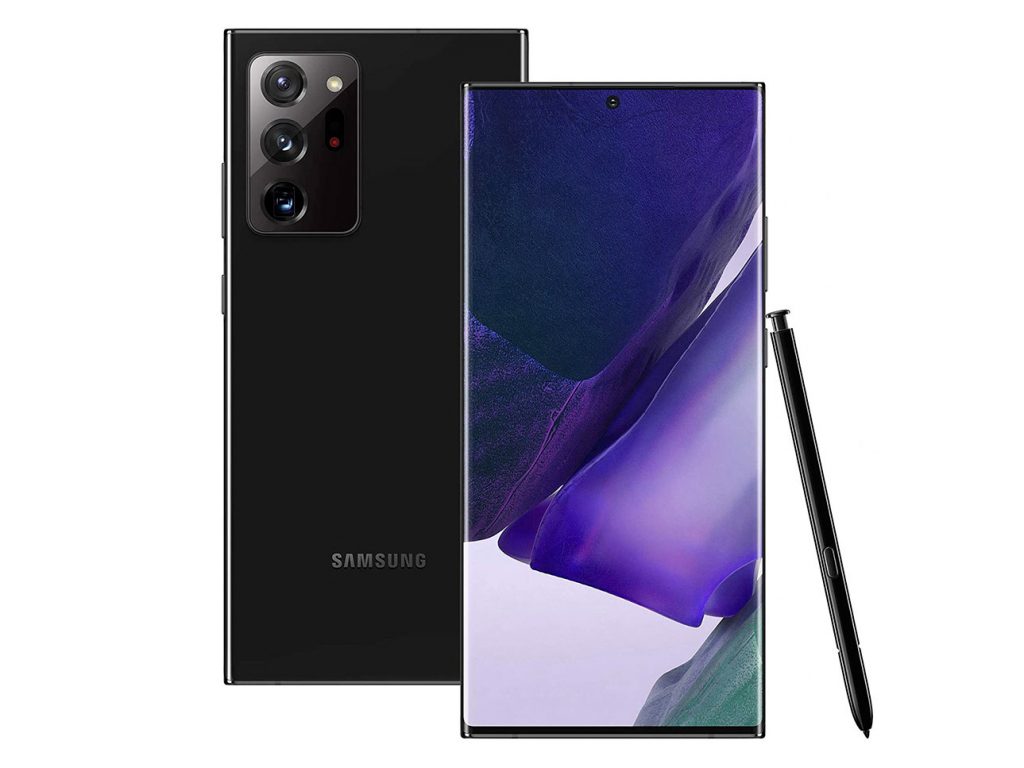


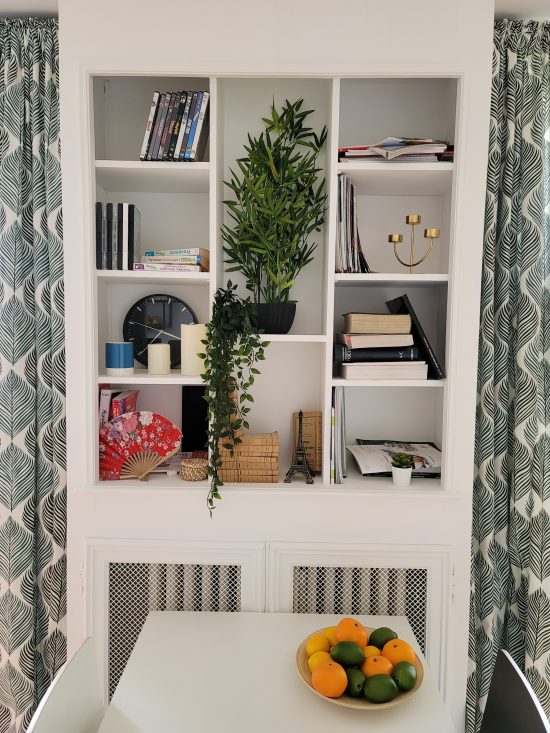
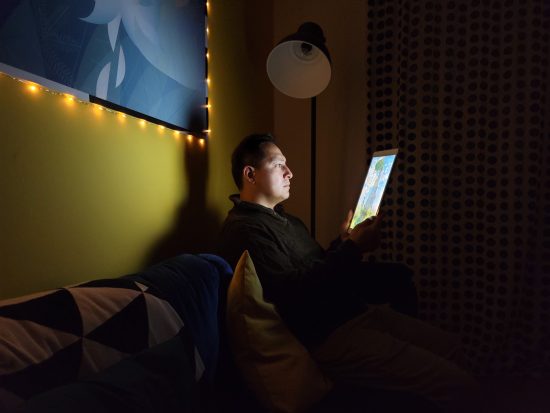


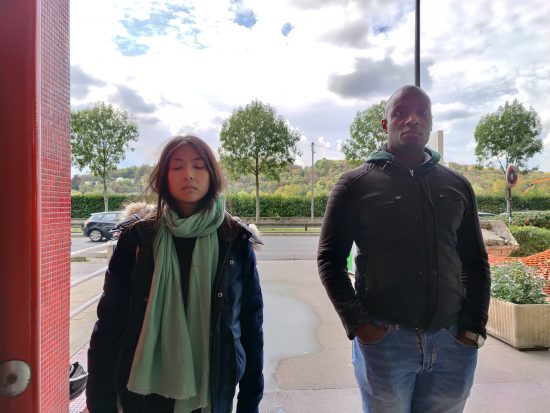

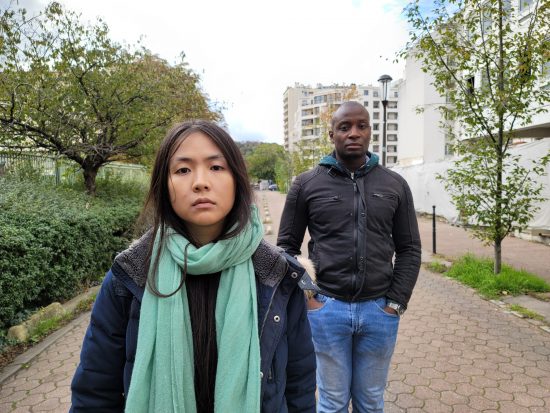

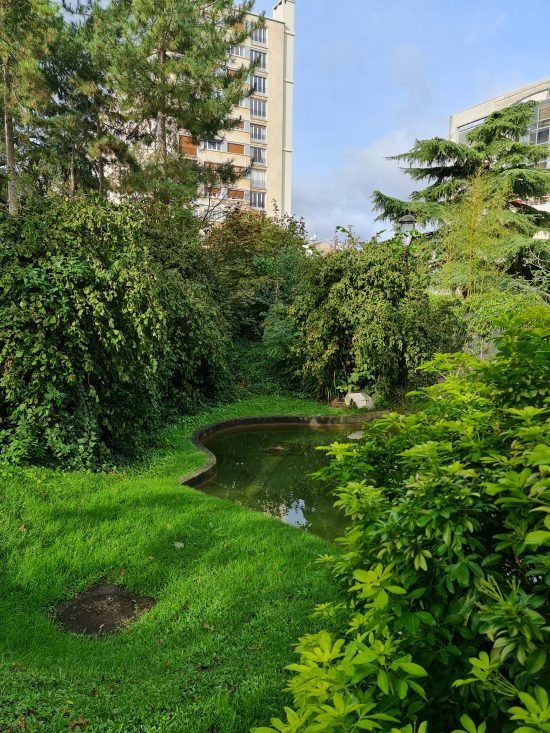




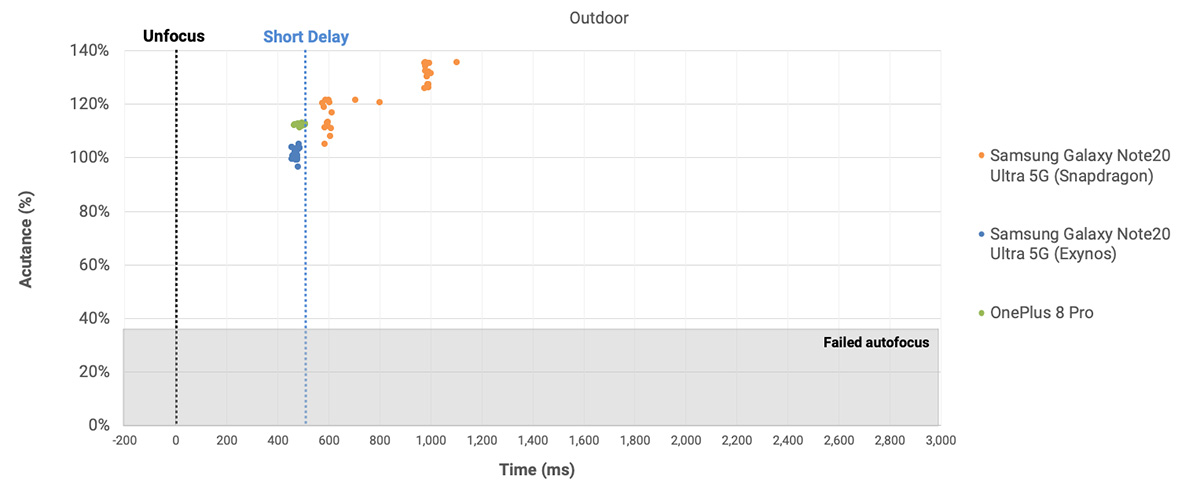



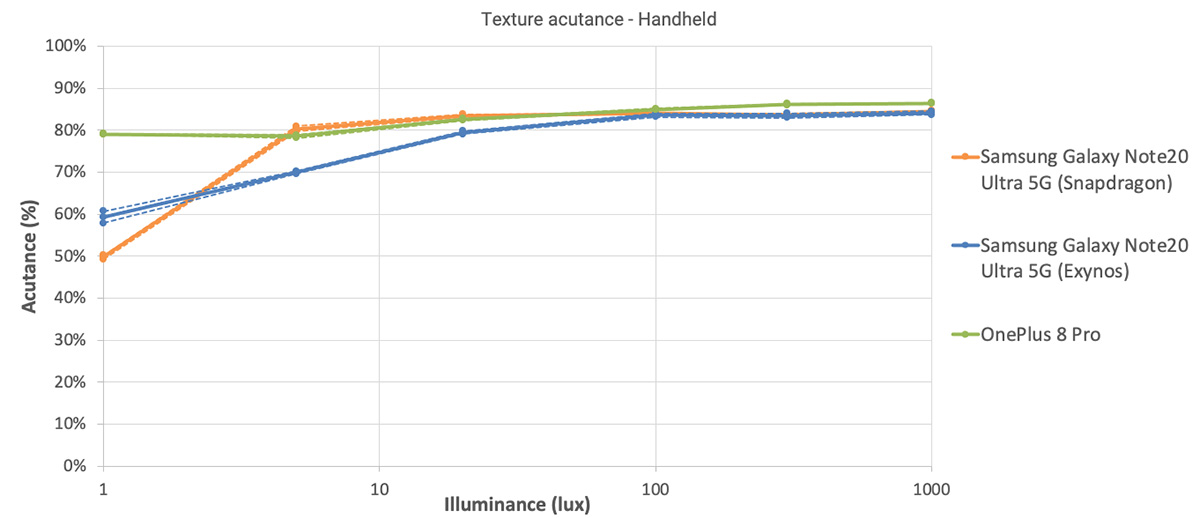



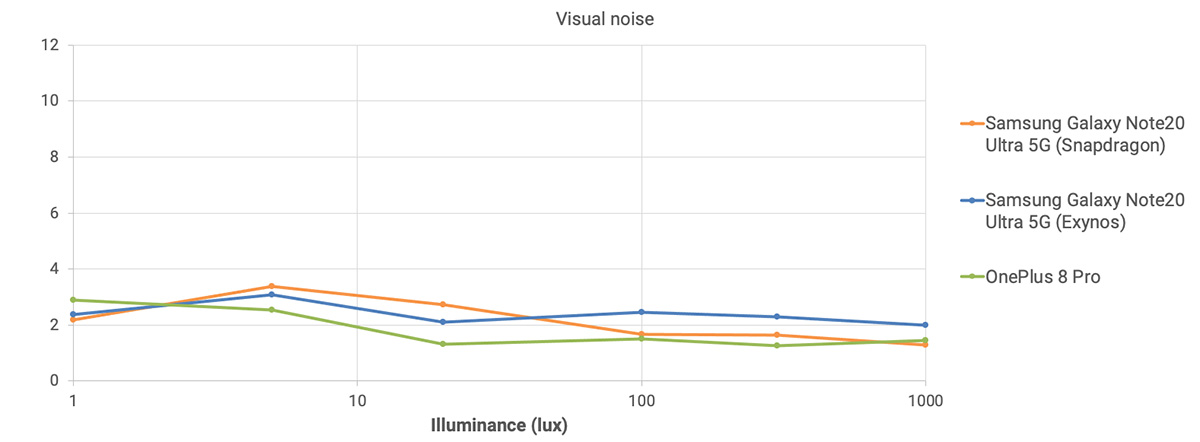
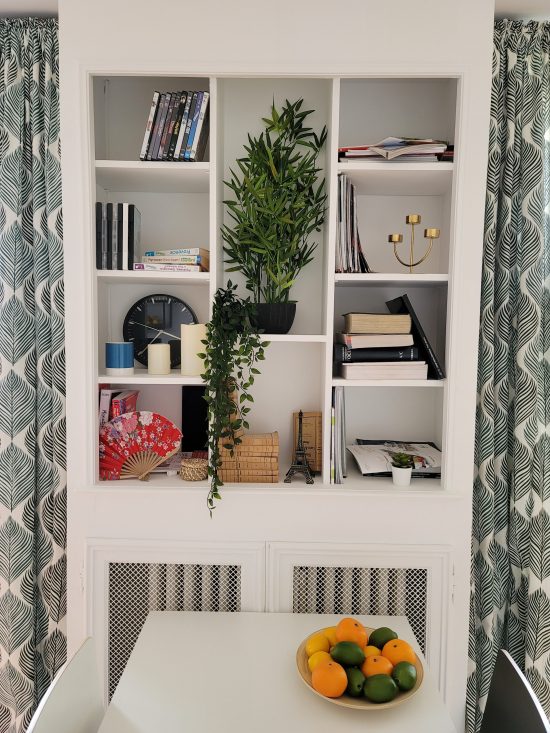
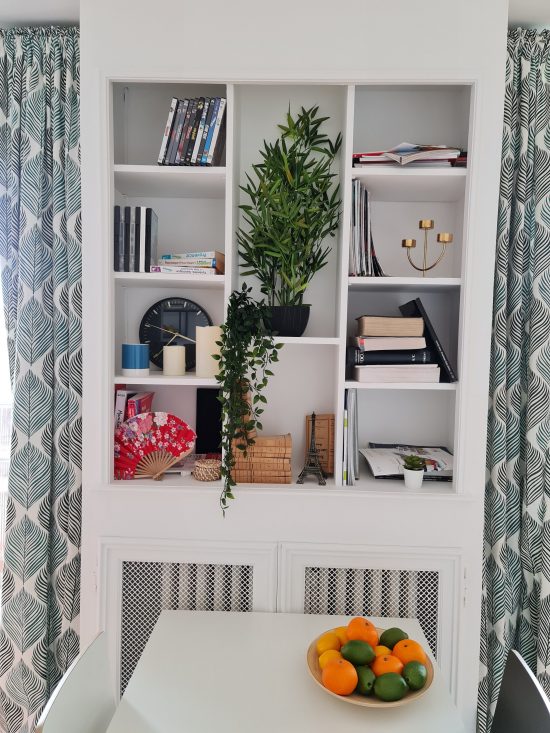
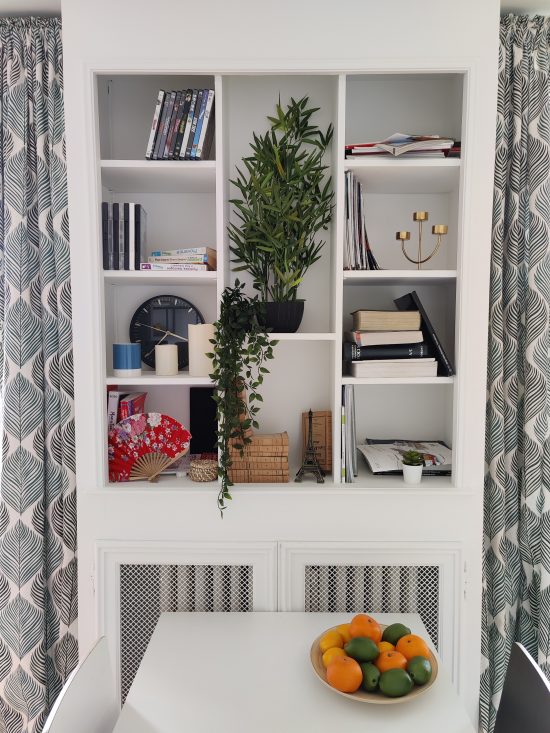
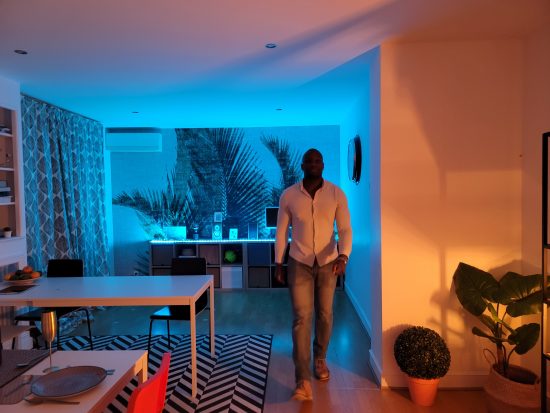
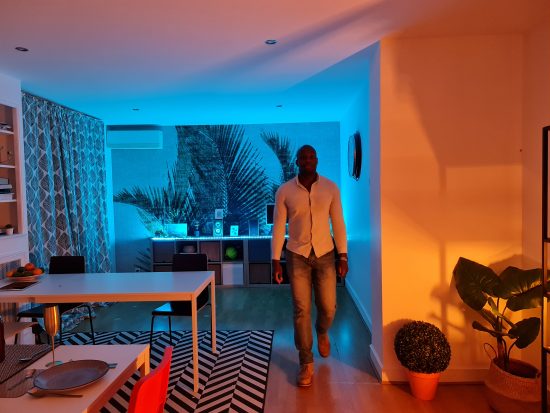
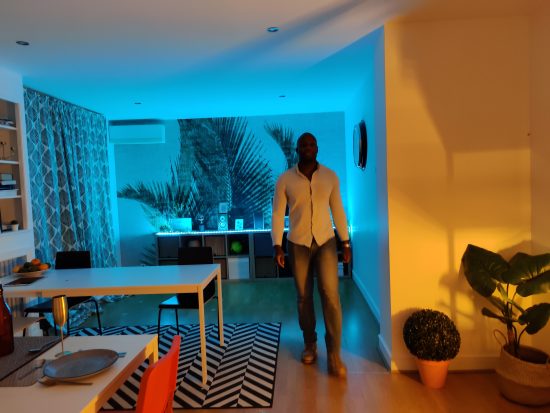
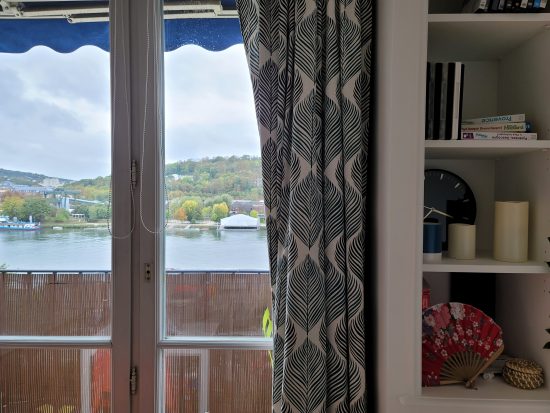

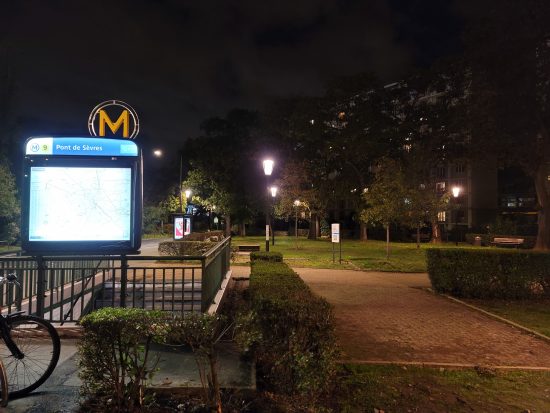
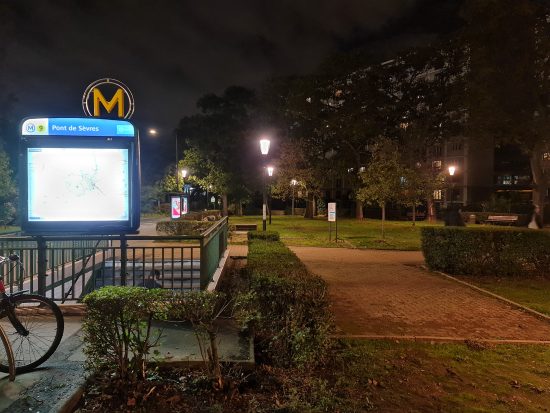
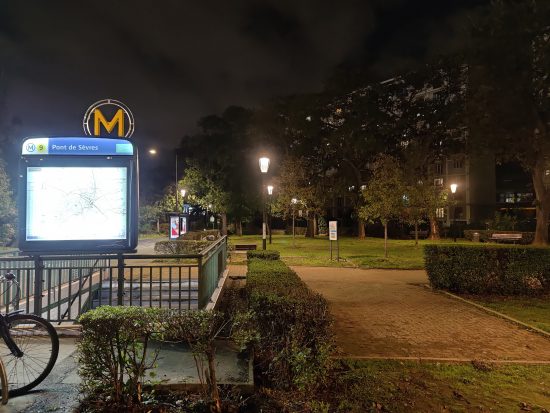





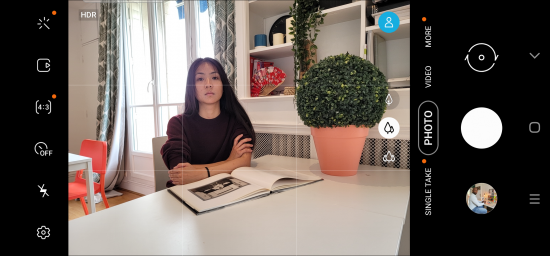


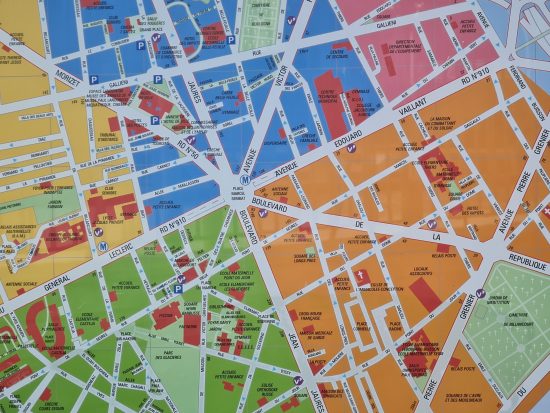




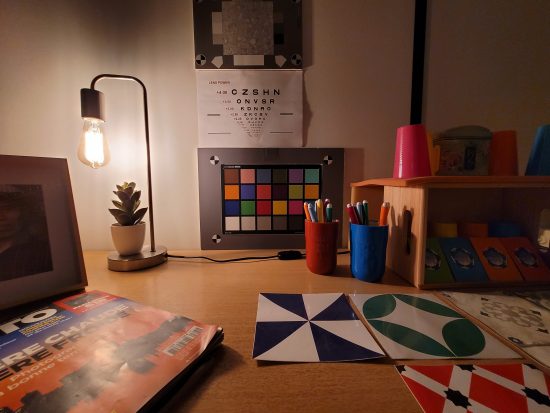
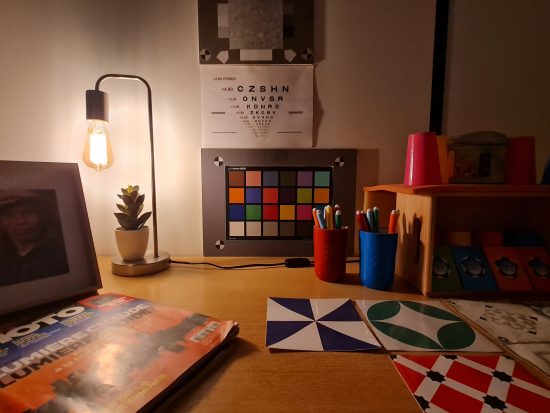

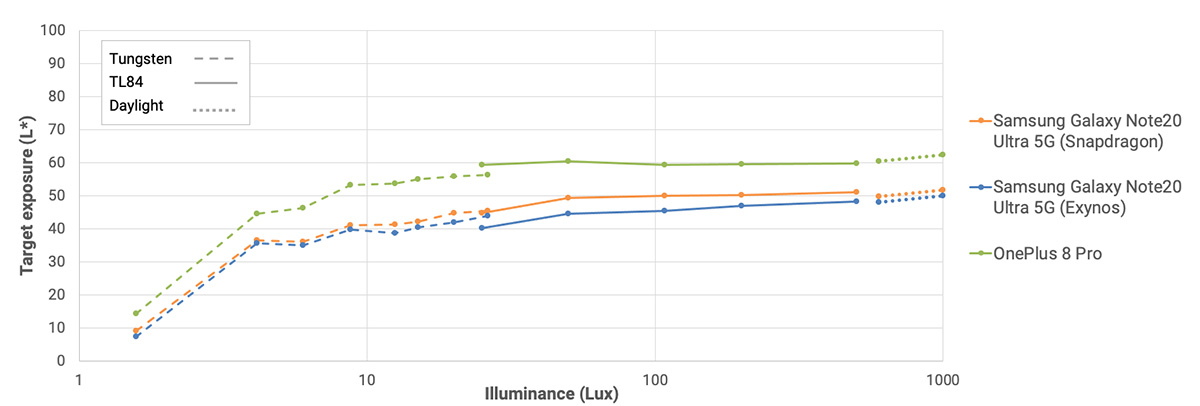
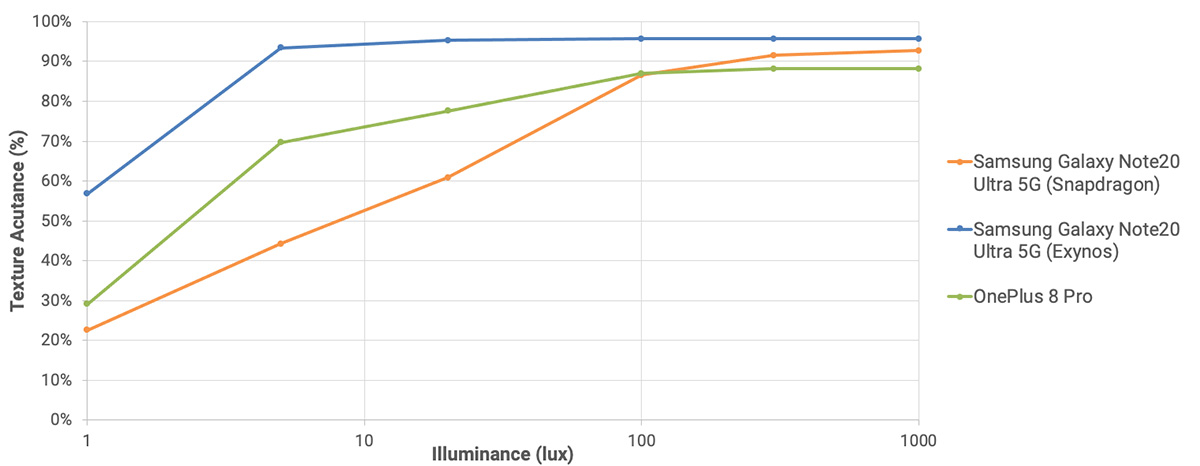



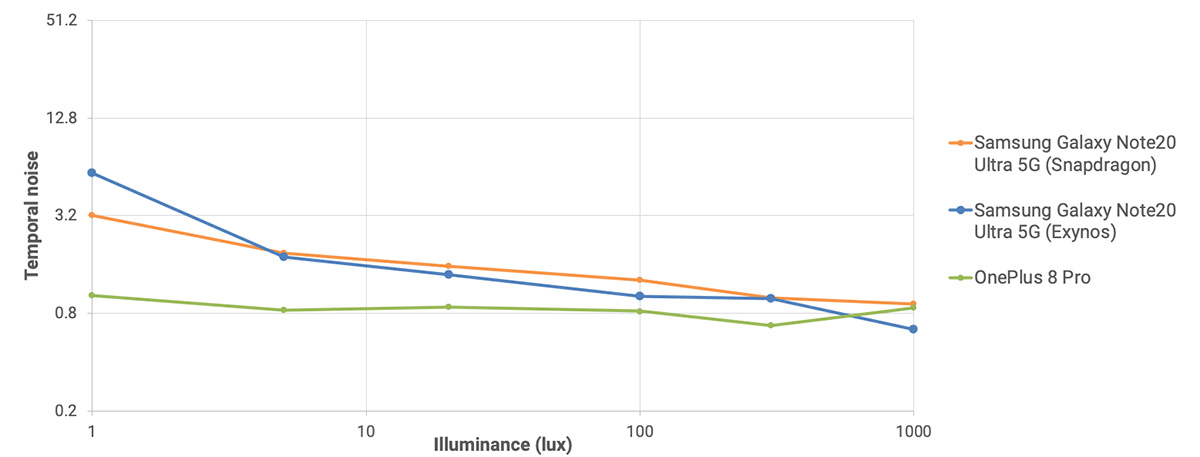
DXOMARK encourages its readers to share comments on the articles. To read or post comments, Disqus cookies are required. Change your Cookies Preferences and read more about our Comment Policy.